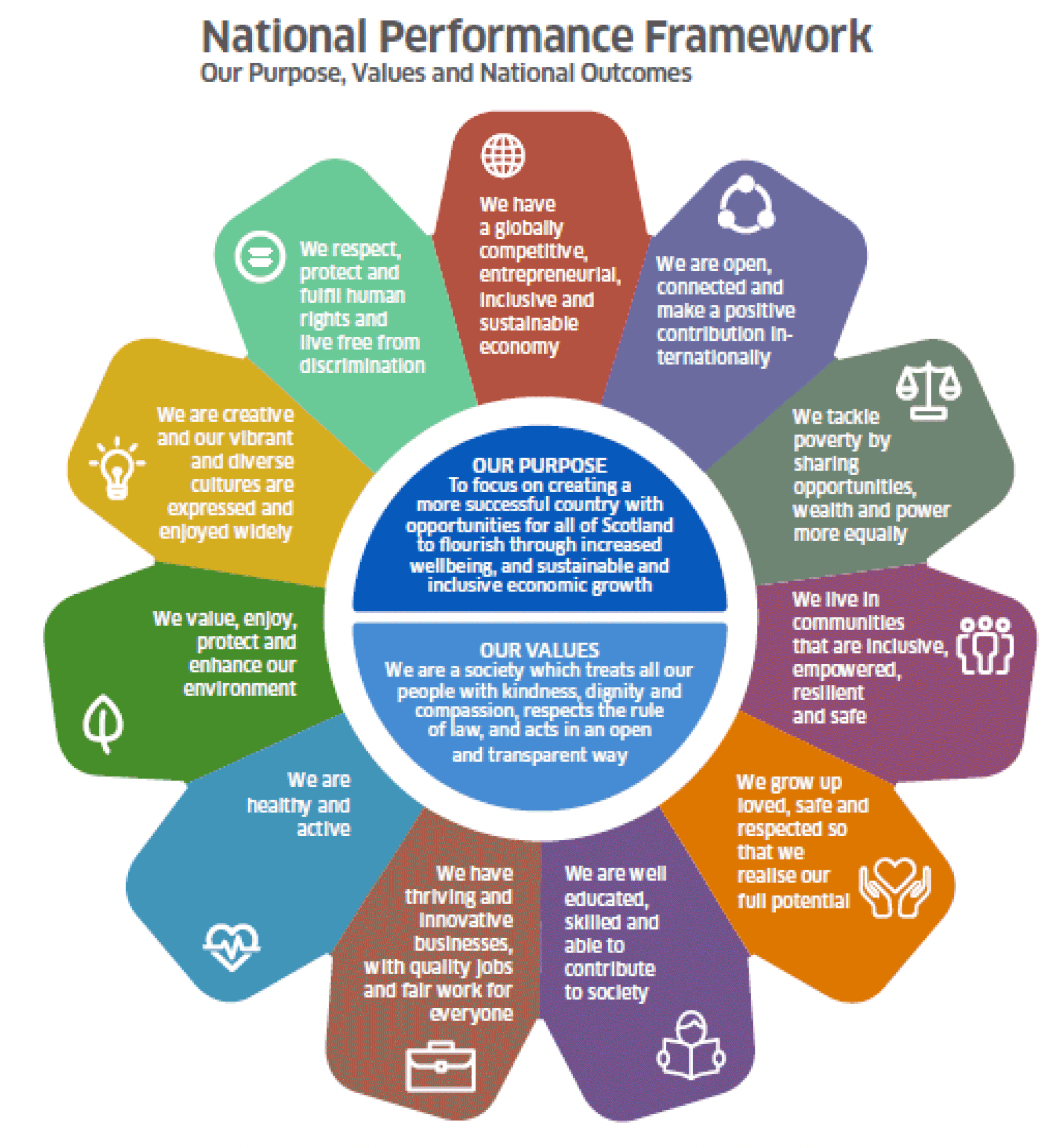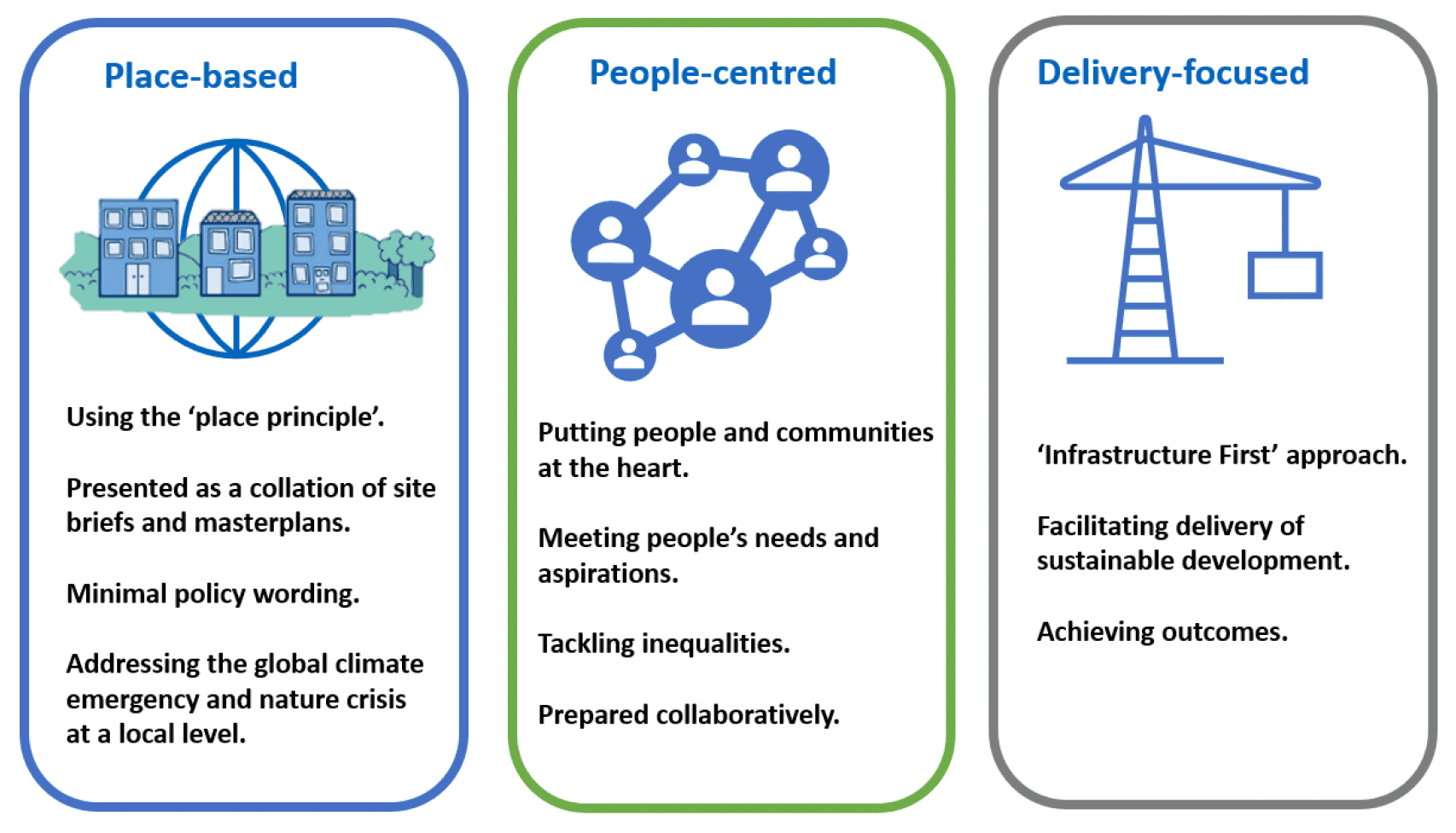Local development planning guidance
Guidance setting out the Scottish Ministers' expectations for implementing the system of local development plans - so that they deliver new-style, place-based, people-centred and delivery-focussed plans. It brings together requirements from the Act and Regulations and advice in relation to National Planning Framework 4.
Aims and expectations of LDPs
14. This section sets out the overall aims for plans prepared under the Town and Country Planning (Scotland) Act 1997, as amended by the Planning (Scotland) Act 2019.
Contributing to the purpose of planning
15. Plans should focus on the outcomes that they deliver for people and places. The Act sets out at section 3ZA that the purpose of planning is to manage the development and use of land in the long term public interest. This includes contributing to sustainable development, and the achievement of the National Performance Framework National Outcomes which describe the kind of Scotland we want to see. A plan-led approach is also central to supporting the UN Sustainable Development Goals (UNSDGs).
16. The cross-cutting nature of development planning means it contributes to all outcomes. Development plans can co-ordinate and align many different sectors and interests to improve places for communities.

Graphic text below:
National Performance Framework
Our Purpose, Values and National Outcomes.
Our Purpose
To focus on creating a more successful country with opportunities for all of Scotland to flourish through increased wellbeing, and sustainable and inclusive economic growth.
Our Values
We are a society which treats all our people with kindness, dignity and compassion, respects the rule of law, and acts in an open and transparent way.
- We have a globally competitive, entrepreneurial, inclusive and sustainable economy
- We are open, connected and make a positive contribution internationally
- We tackle poverty by sharing opportunities, wealth and power more equally
- We live in communities that are inclusive, empowered, resilient and safe
- We grow up loved, safe and respected so that we realise our full potential
- We are well educated, skilled and able to contribute to society
- We have thriving and innovative businesses, with quality jobs and fair work for everyone
- We are healthy and active
- We value, enjoy, protect and enhance our environment
- We are creative and our vibrant and diverse cultures are expressed and enjoyed widely
- We respect, protect and fulfil human rights and live free from discrimination
Plans for the future
17. LDPs should consider the ambitions and outcomes for an area, looking 20 years ahead. LDPs should focus on showing the spatial implications of national policy for different places, and will have fewer thematic policies and written text than previously. They can, however, include local polices that reflect local issues and context, where the planning authority considers this is required.
18. They should be place-based, relevant, accessible and useful to people with an interest in their place. Plans should be developed in collaboration with a wide range of stakeholders and based on robust evidence so that they are deliverable.

Graphic text below:
Place-based
- Using the ‘place principle’.
- Presented as a collation of site briefs and masterplans.
- Minimal policy wording.
- Addressing the global climate emergency and nature crisis at a local level.
People-centred
- Putting people and communities at the heart.
- Meeting people’s needs and aspirations.
- Tackling inequalities.
- Prepared collaboratively.
Delivery-focused
- ‘Infrastructure First’ approach.
- Facilitating delivery of sustainable development.
- Achieving outcomes.
19. So that LDPs are deliverable, place-based and people focused, they should take an Infrastructure First approach. This involves the consideration of infrastructure implications at every stage of the plan making process, and in particular at the early stages when initial thinking is being given to opportunities and challenges for an area and how it may evolve in the future.
20. LDPs should encourage, promote and facilitate development that addresses the global climate emergency and nature crisis, in order to reflect the significant weight that this carries within NPF4.
Place-based
21. LDPs should tell a clear and compelling story about the future of places.
22. The Place Principle promotes a joined-up and collaborative approach to decisions about a place's assets and services. Thinking about places in the round can help bring ideas together and overcome organisational and sectoral boundaries. Development planning has a leadership role to play in putting this approach into practice. By working with others across the public, private, third and community sectors, development planning can make sure that development meets our needs and aspirations and can be implemented in practice.
23. A clearer focus on place will support public engagement with development planning. People are more likely to take an interest in the LDP if it is clearly relevant to the places they live, work and spend their time.
24. LDPs are expected to be place-based, visual plans with the inclusion of a clear spatial strategy reflected more in a collection of maps, development briefs and masterplans than in lengthy written text and policy. LDPs should implement national planning policies by setting out a spatial strategy that shows what they mean for change and development in a particular place.
25. There isn't just one way to tell the story of a place, and different tools – including graphic and digital approaches – will work better in different places. There should however be universal focus on clarity, succinctness and accessibility for everyone who will use the plan.
26. The best practice guide Designing for a Changing Climate: Planning Reform by Architecture & Design Scotland outlines general principles for content and graphic communication for development plans. The Our Place website highlights different approaches to presentation and graphic communication. This provides ideas and prompts thinking on how best to present new place-based LDPs. The content of the plan will be a matter for each planning authority to determine of their own accord, in line with this guidance. There is no single 'perfect plan', it is important that plans are tailored to reflect their local area.
27. LOIPs must be taken into account in preparing LDPs. They aim to meet the diverse aspirations and challenges of their places. Plans should explain how the LOIP vision relates to development and land use so that their alignment is strong. There is no need for an LDP to provide a separate vision statement. This will avoid creating any potential duplication or confusion.
People-centred
28. Planning authorities should consider how LDPs can best meet the needs and aspirations of the different people who have an interest in a place.
29. NPF4 sets out that Scotland's future places will have homes and neighbourhoods that are healthier, affordable and vibrant places to live. LDPs can help make better places a reality for people by addressing longstanding inequalities and eliminating discrimination. They can support development of cleaner, safer and greener places, including improved open spaces which build resilience and provide wider benefits for people, health and biodiversity. This guidance gives more information about taking NPF4 policies into account in the preparation of Evidence Reports, Proposed Plans and Delivery Programmes.
30. LDPs have an opportunity to implement community wealth building by reflecting a people-centred approach to local economic development. This approach focuses on regenerating places, retaining wealth locally, supporting a just transition, addressing economic and health disadvantages and inequality, and providing added social value.
31. Our places can only work for everyone if the views of all are properly understood. The preparation of LDPs should be collaborative, giving everyone an opportunity to help shape their local neighbourhoods. This will take into account different aspirations of communities of place and interest.
32. Engagement, undertaken in line with statutory requirements, should be early, collaborative, meaningful and proportionate, with views taken into account. This should also take into account who may be directly, or indirectly, impacted by proposals, providing opportunities for a diverse range of people to express their views in different ways. Requirements for engagement are set out in detail within the Step by Step guide section of this guidance, including in relation to the Participation Statement.
33. Additional guidance on effective community engagement provides further detail. Over time this will be supported by the sharing of examples of how effective engagement has been achieved in practice.
34. NPF4's six qualities of successful places recognise diversity as an integral part of placemaking. LDPs can support development that helps to eliminate discrimination and promote equality. To do this they will need to be informed by an understanding of how different people experience places.
35. People with protected characteristics, including disability, race, age, gender, sex and sexual orientation, and people from a range of socio-economic backgrounds, must be given particular support to express their views on plans. Children and young people will also have an important contribution, given the long-term impacts of planning for future generations. Women, people from an ethnic minority, disabled people and their representatives, and older people can face particular challenges in navigating the built environment safely and confidently, and seeking their input can inform solutions to ensure places work for all of us. It is important for decision makers to be mindful of intersectionality; where more than one social identity overlaps and impacts on people's experience.
36. Putting the Place Principle into practice and delivering on LOIPs involves a wide range of public, private, community and third sector people and organisations, who all have a stake in the future of our places from the national to the neighbourhood scale. This is where development planning has a coordinating role between a wide range of interests. Bringing different interests together to collaborate can help to exchange experiences and perspectives, and to break down barriers.
37. LPPs have an important role to play in voicing the aspirations of local people. The Act requires that registered LPPs are taken into account in preparing the LDP. This will help LDPs reflect their communities' place-based aspirations. Regulations on LPPs are in force and guidance is also available. Further information can be found at the Our Place website and Annex B provides guidance on the link between LDPs and LPPs.
38. Innovative approaches to engagement, for example community-led design or the Place Standard Tool can be used to stimulate early engagement and inform the Evidence Report. Where needed, mediation initiatives tailored to particular circumstances can also be used.
Delivery-focused
39. LDPs should support delivery of development that meets people's needs and aspirations of a place and the long-term public interest. To be deliverable, a plan must be clear about what is sustainable, desirable and achievable.
40. The LDP should support decisions to invest in a place, identifying priorities and making strong links with the Delivery Programme. A focus on delivery of outcomes requires delivery to be a key theme, considered throughout each part of the plan's preparation and implementation.
41. An infrastructure first approach, as set out in the glossary of NPF4, is key to plans that deliver. This means, in preparing LDPs:
- putting infrastructure considerations at the heart of spatial planning;
- infrastructure 'thinking' should be an integral part of the plan preparation process, from the outset;
- ensuring a robust evidence base including on infrastructure capacity and condition;
- infrastructure considerations should inform site selection and the evolution of the spatial strategy, not be a by-product of it; and
- LDPs and their Delivery Programmes should be clear about infrastructure need and how it will be delivered, so that ambitions are realised.
Contact
Email: ldpregsandguidance@gov.scot
There is a problem
Thanks for your feedback